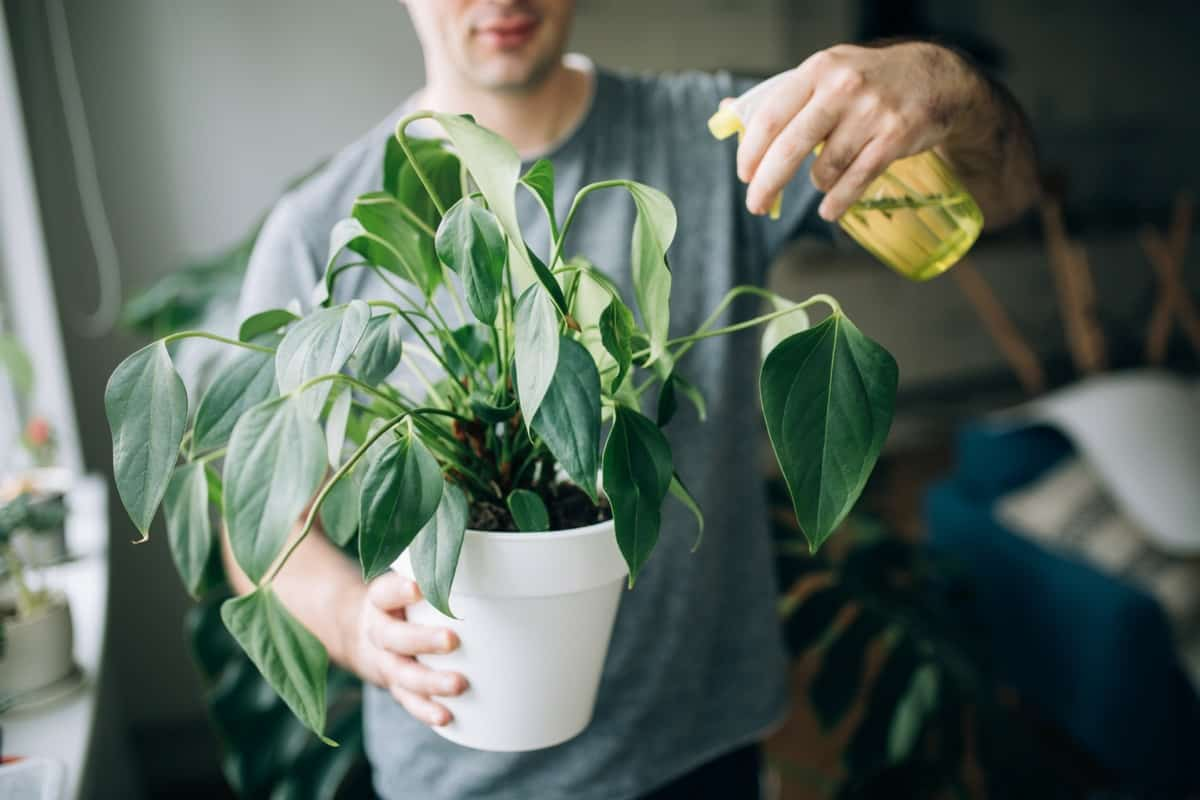In-home gardening, one constant challenge is dealing with pesky bugs and plant diseases. The good news is that a solution might be sitting right inside your pantry. Yes, we’re talking about vinegar. Not just a kitchen staple, vinegar has proven to be a trusted ally for organic gardeners as a natural bug spray for plants. This article explores the specifics of a homemade vinegar spray, how it keeps bugs off plants, its effects on plant diseases, and much more.

Homemade DIY Vinegar Spray for Pest and Disease Control
What is Vinegar Spray?
Vinegar spray is a solution from vinegar, water, and sometimes additional substances to enhance potency. It is an organic, homemade spray to keep bugs off plants. Besides its bug-repelling properties, vinegar spray is also beneficial for disease control in home gardens. The acetic acid in vinegar provides the necessary punch to make this solution a reliable home remedy for plant pest and disease control.
What Are the Ingredients Needed to Make Vinegar Spray?
You need only a few readily available ingredients to prepare a vinegar spray. The key ingredient is white distilled vinegar, a common item in most household kitchens. It’s the base ingredient and source of acetic acid. The other main ingredient is water, which dilutes the vinegar to a suitable concentration. Depending on the severity of the pest problem or disease, you might consider adding a small amount of liquid dish soap. It helps the spray stick to the plants, ensuring more effective pest control.
Recipe/Prepare Vinegar Spray at Home
The preparation of vinegar spray is easy. First, combine one part white distilled vinegar with one part water. This 50:50 solution should suffice for a basic pest problem. However, if you’re dealing with a more serious infestation or disease, consider a stronger solution of two parts vinegar to one part water. Finally, for a more persistent problem, add a teaspoon of liquid dish soap to a quart of your vinegar solution. Mix all the ingredients, then transfer the mixture into a spray bottle to make your indoor plant bug spray.
How Does Vinegar Spray Work?
The working principle of vinegar spray revolves around the acetic acid found in vinegar. When sprayed onto the pests or the affected plant areas, the acetic acid’s strong properties disrupt the pests’ physiological functions, leading to their demise. Additionally, acetic acid helps inhibit the growth and spread of fungi and other disease-causing organisms. In this way, the vinegar spray serves as a homemade solution to keep bugs off plants and control plant diseases.
What Pests and Diseases Can Vinegar Spray Control?
Vinegar spray can manage various pests, including aphids, ants, and mites. It is also effective against slugs and snails. Vinegar spray is effective against fungal diseases like powdery mildew and black spot. However, keep in mind that vinegar spray is a contact pesticide, which means it must be sprayed directly onto the pests or the affected areas to be effective.
How to Store Vinegar Spray?
Once prepared, vinegar spray should be stored in a cool, dark place to maintain potency. You can keep it in the original spray bottle. Ensure a tight seal to prevent vinegar from evaporating and reducing the solution’s long-term effectiveness. Be sure to label the bottle appropriately to avoid any confusion or misuse.
In case you missed it: Homemade Milk Spray for Pest and Disease Control: Recipe for Natural and Organic Benefits of Plants

How Often Should You Use Vinegar Spray for Your Plants?
The frequency of vinegar spray application depends largely on the severity of your pest or disease problem. For minor infestations or diseases, spraying once a week should suffice. However, if you’re dealing with a severe infestation or disease outbreak, you might need to spray every few days. Monitor your plants closely and adjust the application frequency as necessary.
Best Time to Apply and How Much Vinegar Spray Should You Use For Your Garden Plants?
Early morning or late evening is the best time to apply vinegar spray, as direct sunlight can cause the vinegar to burn plant leaves. As for quantity, ensure a thorough application so that all pests or affected areas are adequately covered. However, avoid drenching the plant, as excessive moisture can encourage the growth of fungi and other diseases. When using vinegar spray for the first time, it’s a good idea to test it on a small area first and check for any adverse reactions.
How Long Does It Take for Vinegar Spray to Work for Your Plants?
The effects of vinegar spray can be seen relatively quickly, often within a day or two. You should notice a significant reduction in the number of pests. For plant diseases, improvements might take a bit longer, depending on the severity of the disease. Continue regular applications until you see improvement.
Benefits of Plants of Using Vinegar Spray in the Home Garden
Vinegar spray offers numerous benefits for home gardeners. It is a cost-effective solution, utilizing readily available ingredients. It’s a natural, non-toxic pest control method, safe for the environment and non-target organisms. Additionally, it provides an alternative to chemical pesticides, reducing the risk of pests developing resistance.
Safety Precautions When Using Vinegar Spray
While vinegar spray is a safer alternative to chemical pesticides, handling it with care is essential. Always wear gloves when preparing and applying the spray to protect your skin from acetic acid. Don’t spray on windy days to keep the spray out of your eyes. Keep the spray out of reach of children and pets. Lastly, remember that vinegar spray can harm beneficial insects and damage plant tissue if not diluted properly or used excessively. Therefore, always test the spray on a small area first and monitor the plant’s response.
Observing Results and Adjustments
After the initial applications of vinegar spray, monitoring your plants closely for changes is important. If you observe a significant decrease in the pest population and disease symptoms, continue with your current application frequency. However, if the pests or diseases persist or worsen, you might need to increase your vinegar solution’s concentration or the application frequency.
In contrast, if you notice any signs of damage or stress in your plants due to the vinegar spray, you might need to reduce the concentration or switch to a less frequent application schedule. Always remember that the goal is to strike a balance where the vinegar spray effectively controls pests and diseases without causing harm to your plants.
In case you missed it: Benefits of Apple Cider Vinegar for Chickens: Preparation, Dilution Rate, and Giving Procedure

Conclusion
Vinegar spray is a potent tool in the organic gardener’s arsenal, providing an environmentally friendly solution to common pest and disease problems. By understanding how to prepare and apply it effectively, you can harness its power to keep your home garden thriving.
- Feed Your Flock for Less: Top 10 Tips to Save on Chicken Feed
- Ultimate Guide to Ossabaw Island Hog: Breeding, Raising, Diet, and Care
- Hatching Answers: The Top 10 Reasons Your Chickens Aren’t Laying Eggs
- Eggs and Economics: Breaking Down the Cost of Raising Backyard Chickens
- Defend Your Greens: Proven Methods to Keep Iguanas Out of Your Garden
- Ultimate Guide to Cinnamon Queen Chicken: A Comprehensive Guide for Beginners
- Ultimate Guide to California Tan Chicken: Breeding, Raising, Diet, Egg-Production and Care
- Ultimate Guide to Marsh Daisy Chicken: Breeding, Raising, Diet, and Care
- 10 Types of Chicken Farming Businesses You Can Start for Profits